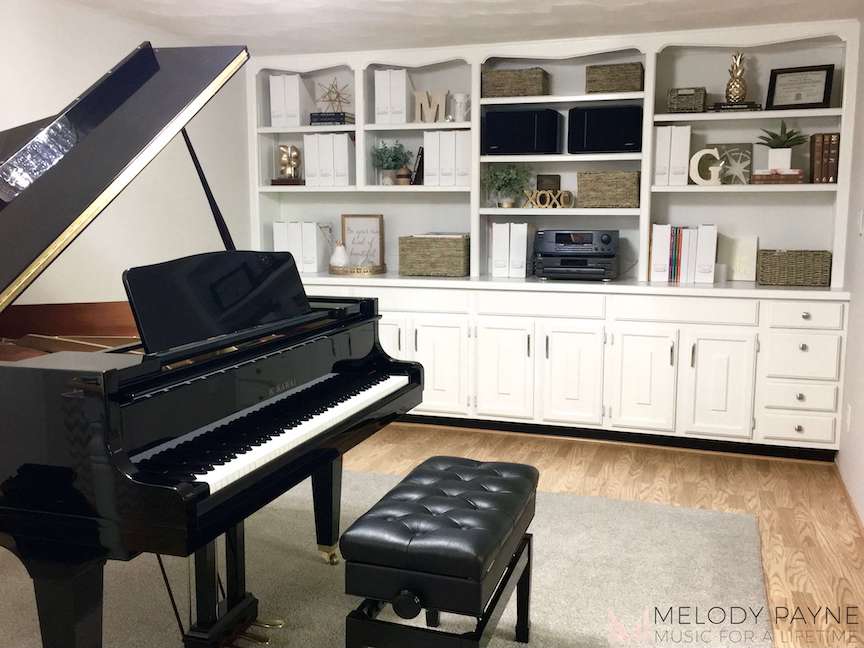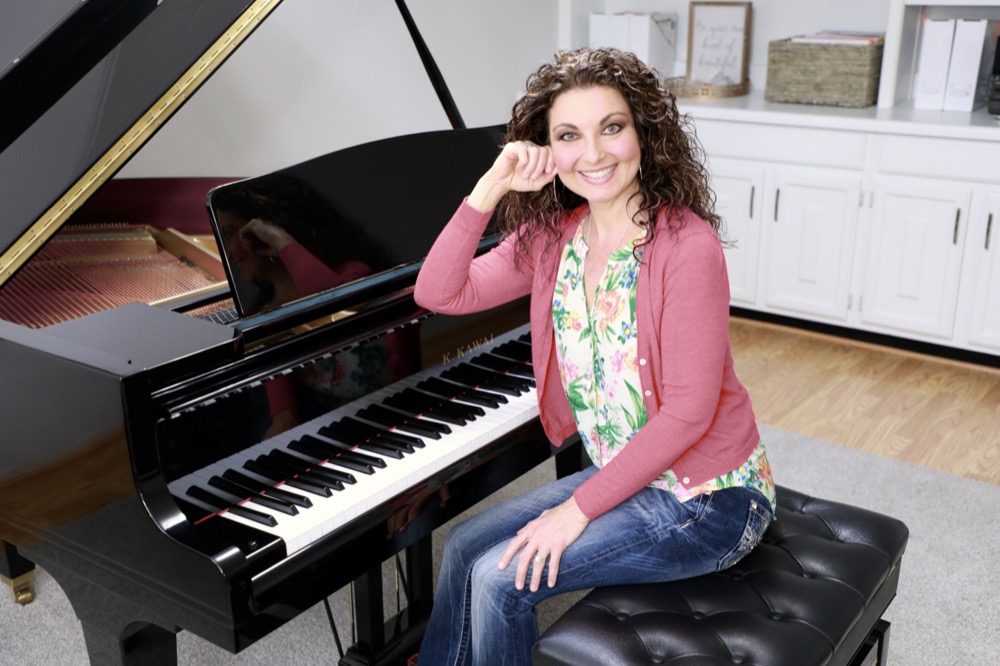How to Create the Best Audio for Online Piano Lessons
This post may contain affiliate links. If you purchase something through an affiliate link, I will receive a small commission at no cost to you. For more information, read the disclosure statement here.

Inside: Three essential components that create crystal-clear audio for online piano lessons that sounds like students are right in the room with you! These game-changing tips cover choosing the right USB microphone, setting up external speakers to eliminate those frustrating “What did you say?” moments, and optimizing Zoom settings with original sound for musicians and high-fidelity music mode. Your online teaching will become incredibly immersive and satisfying when you can hear every subtle dynamic nuance and articulation clearly – no more auditory fatigue from straining to hear through laptop speakers, and your students will stay engaged because excellent audio makes lessons so much more enjoyable!
Table of Contents
Teaching piano lessons online offers many benefits like flexibility, accessibility, and comfort, but it can also present challenges for piano teachers looking to expand their studio by teaching online for the first time.
One potential hurdle is figuring out how to set up the best audio for online piano lessons. It may seem a little overwhelming at first, but excellent audio during online piano lessons is crucial for our online students and for ourselves.
In this article, I’ll share three key tips for creating fabulous audio for online piano lessons (and if you need help from the very beginning, read my article, How to Help Your Students Set Up for Online Piano Lessons)
Read all the way to the end for a fun fact about online piano teaching!
Here are 3 reasons Why Excellent Audio for Online Piano Lessons is Non-Negotiable
Delivers The Most Accurate Sound Representation
A well-configured audio setup can tremendously improve the audio for online piano lessons.
In my studio, this is non-negotiable for my own setup and for my students.
A good audio setup enhances the depth and richness of the tones and provides a higher level of detail and nuance that allows us to teach our students with more depth and musicality.
Without accurate sound reproduction, our students might not fully grasp what we are trying to teach, and we may not be able to effectively correct or guide our students on a deeper level.
Encourages The Best and Most Effective Communication
To successfully teach piano online, we need to provide clear instructions and feedback for our students based on what we see and hear them doing.
Superior sound quality in our audio setup for online piano lessons ensures that our verbal communication is crystal clear.
This helps us teach without the amount of echo, distortion, or audio “cutting out” that could lead to misunderstanding or misinterpretation by our students.
This also applies to our online students, because we need to hear every note, articulation, and variation in dynamics distinctly to offer our very best evaluation and feedback each week.
Enhances the Teaching and Learning Experience
High-quality audio makes online piano lessons more immersive and enjoyable.
When the audio equipment captures the subtleties and nuances of a piece, this gives us more opportunities to teach more profoundly and nurture our student’s musicality in ways that promote growth in their playing.
Excellent audio also helps keep students engaged and motivated by reducing the fatigue and stress that can be associated with poor audio quality week after week.
This leads to more productive and rewarding learning experiences for our students and for us!
Equipment Needed for a Terrific Audio Setup for Online Piano Lessons
To ensure that your online piano lessons are high quality and serve your students well, investing in the right equipment is essential.
The three key components for fabulous audio for online piano lessons are:
- A good microphone
- An external speaker
- Optimal software settings
Here’s a closer look at each piece.
A USB Microphone Helps Create Fantastic Audio for Online Piano Lessons
Whether you’re an online teacher or a student taking lessons online, a quality microphone is a must-have for online piano lessons.
My top recommendation for a USB microphone is the Blue Yeti. I have used a Blue Yeti for teaching online for many years, and it continues to be my top choice.
The Blue Yeti is a powerful, versatile microphone for online piano lessons that is capable of capturing an incredibly authentic sound from your piano.

I love my Blue Yet, but it might not be in the budget for everyone. Recognizing that budget can be a concern, I recommend a more affordable option for my students, the Fifine K669B.
It’s a high-quality microphone with a built-in sound card that offers great sound quality for its price, and it makes a world of difference in audio for my online students.
Regardless of what microphone you choose, take a few minutes in the next online lesson to find the optimal volume, settings, and placement near the piano so that you and your student hear the best representation of sound possible.
Here’s what Greg said about his new audio setup:
Just wanted to you let you know that I purchased the streaming mic you use, and a family I do online lessons with had a streaming mic as well. I couldn’t believe how GREAT the audio was when playing instruments (guitar or piano or listening to vocals) was. NIGHT AND DAY difference. Thank you so much. It changed the whole experience for me and the students. I used FaceTime with this family. I have yet to experiment with ZOOM but plan to work on that next. Just a thank you and FYI.
Greg T.
An External Speaker Helps Create The Best Audio for Online Piano Lessons
In addition to a great microphone, a high-quality speaker is highly recommended for online piano lessons.
It’s very difficult to teach a 6-year-old when you give a short and specific directive and he looks at you and says, “What did you say?” after every single sentence. True story!
But an external speaker can solve that issue for your student immediately! And it doesn’t have to be expensive.
A speaker connected directly to your laptop is usually the best option.
USB speakers are a great choice because they can easily be connected to your laptop and can provide much better sound quality than built-in laptop speakers.
All of the speakers in our home are Bose products, and I don’t believe you can go wrong with that brand. Here are two that we own and love:
- Bose SoundLink Portable Speaker
- Bose SoundLink Speaker III
- Audio Cord: Choose an appropriate audio cord to connect your speaker to your laptop.
My favorite audio setup for my own use is a surround sound setup with a receiver and speakers.
I run a cord from the receiver and plug the cord into my MacBook Pro’s audio/headphones port.
The audio from my students goes through the receiver and plays through the bookshelf speakers, and it is fabulous.
- Bose Surround Sound Speakers: Ours are several years old and awesome, and here are some newer options.
- Onkyo Receivers: I have the MRX in my studio, and we have the THX in our living room.
- Bonus: If you’re looking for a comfortable piano bench for teaching online piano lessons, I love my adjustable piano bench.

My speaker setup, when used in combination with each student’s USB microphone, creates a much more immersive audio experience for me, which is incredibly beneficial for several reasons:
- I am able to hear much more subtle nuance in dynamics in my students’ playing.
- I can more thoroughly hear and teach complex pieces.
- It creates a much richer and deeper sound than smaller USB speakers.
- This setup creates such great audio for online piano lessons that it sounds like my online students are actually in the room with me!
- All of the above things eliminate the auditory fatigue I used to get from trying so hard to hear my students through my laptop speakers.
- I am much less tired and tons more aurally satisfied at the end of my online teaching day!

I need to mention that Bluetooth speakers, while portable and convenient, may not always be the best choice for online piano lessons.
Bluetooth speakers often have a lag or delay, which can affect real-time performances and feedback during online lessons.
The sound can cut in and out, interrupting the flow and energy of the lesson and disrupting the entire instructional process.
Choosing the right equipment is an important step towards enhancing the audio quality of your online piano lessons and improving the overall teaching and learning experience for yourself and your students.
Optimal Zoom Settings Help Create Optimal Audio for Online Piano Lessons
Zoom is one of the most accessible and popular platforms for online piano lessons. I’ve taught all of my online piano lessons on Zoom for the past several years.
Zoom offers an array of audio settings that can significantly enhance the sound quality of your online lessons.
Whether you’re using a laptop or an iPad, it’s important to adjust these settings correctly to ensure the best audio for online piano lessons.
Have your students make these adjustments and their audio will sound even better too!
For Laptop Users:
To configure the audio settings on Zoom, follow these steps and you’ll have the best audio for online piano lessons:
- Open Zoom, and in the main window, click the small arrow beside the ‘Audio‘ button, the microphone icon at the bottom.
- In the ‘Select a Microphone‘ section, select your USB microphone (It should show up by name, either ‘Blue Yeti’ or ‘Fifine K670’, or whatever mic you have).
- Click the small arrow beside the ‘Audio‘ button again.
- Click ‘Audio Settings‘.
- In the ‘Microphone‘ section, ensure that the checkbox for ‘Automatically adjust microphone volume‘ is not selected. This gives you manual control over the mic’s volume and allows you to adjust it based on the piano’s volume and the room’s acoustics.
- Scroll down and select ‘Original sound for musicians‘.
- Check ‘High-fidelity music mode‘. This improves the standard Zoom audio for music lessons.
- Check ‘Echo cancellation‘ to prevent any echo or feedback noise.
- Check ‘Stereo audio‘. This allows Zoom to use both channels of the microphone and provides a better sound experience.
- Close the ‘Audio Settings‘ window.
- In the main Zoom window, look for ‘Original Sound for Musicians‘ and click it to toggle it on. This setting provides a more authentic and detailed sound, which is non-negotiable for musicians.
For iPad Users:
The Zoom app on iPad also offers the ability of adjusting audio settings, and it’s slightly different from the desktop version of Zoom.
Use these tips to improve your audio and your students’ audio for online piano lessons on iPad:
- Connect your USB mic to your iPad. Your USB mic should automatically be used by your iPad, as long as you connect it to your iPad before joining Zoom.
- Open the Zoom app, and in the main window, tap on ‘Audio‘.
- Under the ‘Audio‘ section, scroll down to ‘Original Sound‘ and tap it to enable it. This allows the app to use the original, unaltered audio from your microphone, crucial for accurate piano audio.
- Unfortunately, Zoom for iPad does not currently support high-fidelity music mode, stereo audio, or echo cancellation in the same way as the desktop version, but setting it up by following these steps will improve the audio quite a bit.
Achieving the best audio for online piano lessons involves a combination of the right equipment and software settings.
These Zoom settings will make your lessons sound as good as they possibly can, which will make online lessons much more effective and enjoyable for you and your students!
Final Thoughts on Improving the Audio for Online Piano Lessons
As online learning continues to evolve, it is so important for us to adapt and optimize our online teaching studio setups to the best of our abilities.
A crucial part of this adaptation is making sure we have the best audio for online piano lessons that we can provide, because this significantly contributes to more effective, engaging, and rewarding learning experiences.
In addition to enhancing the teaching and learning experience in profound ways, it will also increase online student retention!
When you figure out your own optimal setup for online piano lessons, you will also eliminate the non-stop “What did you say?” “What?” “Huh?” comments throughout the day and make the lessons flow much more smoothly!
Whether you’re already teaching online lessons or are considering it, following these recommendations will dramatically improve the sound quality for yourself and your students.
Remember, the key to successful online piano lessons lies not only in your fabulous teaching skills but also in the clarity of audio that you and your students send and receive.
Start enhancing your online piano teaching setup today with one piece of equipment that will help you create fantastic audio for online piano lessons and approach your lessons with renewed enthusiasm. Happy teaching!
Online Piano Teaching Fun Fact
On the day I published this article, August 8, 2024, I am celebrating my 12th anniversary of teaching my first online piano lesson on August 8, 2012!
I love thinking back to those first lessons when we used our old laptops, held lessons on Skype, and did our best with low-quality built-in webcams and laptop speakers. Was it ideal? No, but we persevered, did our best, and made it happen anyway!
I also love looking ahead with excitement for things to come! Technology is evolving all the time, and if the past 12 years are any indication of the improvements and advancements that will happen in online teaching in the next 12 years, let’s welcome the changes so we can help our online students thrive!
Happy Teaching! -Melody
What’s Your audio for online piano lessons setup?
Have you set your Zoom settings? Do you have a mic that works well for you? Comment and share, I’d love to know!
Want more Online Piano Teaching help?
Check out these blog posts!
Don't miss out!
Follow on Facebook and Instagram, join the best Facebook group for piano teachers, and subscribe to the newsletter to get helpful teaching tips, resources, and tutorials delivered straight to your inbox every week.
Melody Payne
Melody Payne
Welcome!

Hi! I’m Melody Payne, a pianist and piano teacher, educational resource author, a fun-loving wife to the most wonderful and talented hubby I could ask for, and a lifelong learner who loves to share. I want to make your life as a music teacher easier by writing and sharing helpful and relevant music teaching articles, and by creating educational resources with your very own students in mind. If you are a parent who wants to enroll your child in piano lessons, I’d love for us to get started building those skills that can give your child a lifetime of musical enjoyment!


This Post Has 5 Comments
The insights on audio quality are precise and invaluable, offering practical solutions for enhancing online piano lessons.
The number of piano teachers offering online lessons grows every day, and I’m glad you found the information useful. Thanks for your comment!
Hi Dr. Payne!
I mostly teach piano lessons in my home, but I do have a few online students. One of them can hear me and my piano just fine, but I can’t hear her piano all the time! I hear her voice clearly, but not when she plays!
I appreciate your tips in my emails for this type of teaching, but I don’t want to lose students because of a financial situation! Therefore, I have not advices this student to get a microphone!
This particular student only lives about 22 miles away from me! But teaching online with her has been so difficult (with her audio being so bad), that’s about what I’ve decided to do!
Do you still recommend the microphone for her?
Hi Karma, I definitely recommend a microphone for your student, if you have already started using the best audio tips for Zoom and still can’t hear her piano. The Fifine microphone is very affordable, and there are lots of other affordable microphones available too. The way I see it, if someone chooses to take online lessons, they need to purchase the required equipment so you can teach them to the best of your ability. Please let me know how it goes after she gets her new mic 🙂
Hi Karma, I have had this problems with a couple of students! If you can hear her voice but not the piano, your student’s internal microphone may have noise cancelling enabled (and it is perceiving the piano as ‘noise’). She needs to go into her laptop microphone settings (not Zoom) and see whether there is something about noise cancellation to uncheck. If she can’t find it, perhaps she can google noise cancellation for her brand of computer.
An external microphone MAY help to solve the problem, but the computer microphone settings may also override it, so you’ll need to experiment! Ideally they’ll purchase an external mic, because it will definitely be better! But in the meantime, sorting out the computer settings may help tide you over.